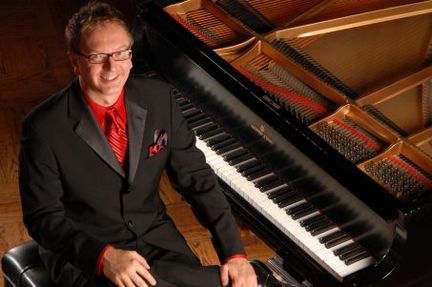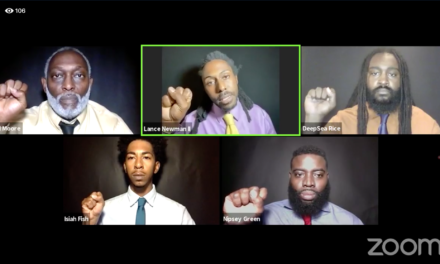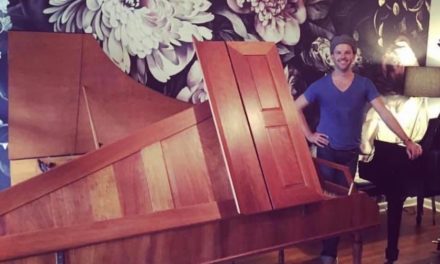Louisville Orchestra: Rhapsody in Blue
Robert Moody, conductor
Kevin Cole, piano
By Beth Brumleve Olliges
Entire contents are copyright © 2013 Beth Brumleve Olliges. All rights reserved.
George Gershwin’s “Rhapsody in Blue” probably ranks among the most recognized American compositions. From Disney’s “Fantasia 2000” to commercials for United Airlines, this piece’s familiar strains have become woven into the fabric of American culture.
Patrons of The Louisville Orchestra’s evening Classics and morning Coffee Classics series were extraordinarily fortunate to be treated to a performance of this work by Gershwin virtuoso Kevin Cole, who was brought in when originally scheduled pianist Markus Groh took ill. Conductor Robert Moody said that Cole has performed this work probably more times than any other person living, and added that even Gershwin’s sister has remarked on how similar Cole’s playing is to her brother’s.
Before the piece, Cole informed the audience they would be hearing some extra measures, but assured them he would not be improvising: apparently, the original publishers had cut some 50 measures (mostly “connecting bridges” as Cole described them), which have now been restored to the score.
Cole also told the audience that this piece almost didn’t happen, and related the story of Gershwin bumping into bandleader Paul Whiteman, who was planning a concert “to define jazz.” Whiteman asked Gershwin to compose a piano concerto, which, according to Cole, Gershwin agreed to and promptly forgot. About two months later, Ira Gershwin read a newspaper article about Whiteman’s concert, which claimed, “George Gershwin is at work on a jazz concerto.”
In a phone call the next day, Whiteman did persuade Gershwin to compose something. But with the concert only five weeks away, Gershwin insisted it would have to be something more free form in nature than a concerto. As Gershwin later related, the full composition came to him on a train trip, inspired by the clickety-clack sounds and rhythms. By the time the piece had been written and orchestrated, there was time for only two rehearsals with Whiteman’s band, and in fact, one place in the score simply instructed the conductor to “wait for nod.”
That premiere concert (whose audience included such musical luminaries as Stokowski, Heifetz and Rachmaninoff) was running long, and many people were starting to leave – until they heard that now-familiar opening clarinet glissando. (According to a book by Charles Schwartz, clarinetist Ross Gorman had played it humorously in rehearsal as a joke, but Gershwin liked it so much, he asked him to perform it that way, and to “add as much ‘wail’ as possible.”)
After relating these stories, Cole finally took his seat at the piano and gave the audience what they’d come to hear – and then some. From his flawless interpretation to the utter joy on his face, it was indisputable how well this gifted artist knows and loves this work. His solo passages were often playful and featured unusual techniques (such as a good deal of cross-hand work and occasionally a sort of “chopping” technique) that I can’t recall seeing very often in more classical piano works.
I was so utterly mesmerized that I realized later how few notes I’d taken because I simply could not tear my eyes away from the combined performance of Cole, Moody and the Louisville Orchestra. All were in such amazing synchronicity that I felt I was witnessing one of those rare musical moments that makes one wish it could last forever, so as not to break the spell. When the piece did come to an end, the energy in the audience’s reaction was palpable, as all leapt to their feet in joyful appreciation, and were rewarded with Cole’s encore of “Rialto Ripples Fascinating Rhythm.”
The concert had begun with “Rainbow Body” by Christopher Theofanidis. According to the program notes, the composer has said this piece brings together his fascination with the music of Hildegard of Bingen and the Tibetan Buddhist idea of an enlightened being’s body returning to the universe as light energy. From a mysterious beginning and the revelation of a lovely, calming melody, this piece built to more urgent feelings, with dissonant brass and agitated strings, and on into a resolution that started with a low heartbeat and layered in the rest of the instruments to a full orchestral climax with vocalizations that might remind one of being on a roller coaster. (Moody, who is friends with the composer, said such vocalizations are a custom of the London Symphony Orchestra when they enjoy playing a piece, and Theofanidis decided to keep them.)
After intermission, the LO gave a lovely performance of the Symphony No. 2 in E Minor by Sergei Rachmaninoff, whose third movement includes the melody later popularized by Eric Carmen’s hit song “Never Gonna Fall in Love Again.” Although this is a beautiful symphony, and the LO played it with their always-impressive blend of tight precision with wonderful sensitivity and emotional nuance, it felt like a let-down after the magical electricity of “Rhapsody in Blue.” The symphony did earn a standing ovation from much of the audience, but it felt more cursory than the joyful exuberance exhibited earlier. Had I been in charge of programming, I would have placed “Rhapsody in Blue” last, to send the audience out on a musical high.
At intermission and after the concert, audience members (including this reviewer) eagerly snapped up copies of Cole’s CD, which includes his solo piano rendition of “Rhapsody in Blue.” While not as grand as the orchestral version, it does capture Cole’s virtuosity. Those who were not fortunate enough to attend the concert (or those who understandably want to relive it) can listen to a recording on Classical 90.5 FM or wuol.org on Saturday, November 9, at 6 p.m.
Louisville Orchestra: Rhapsody in Blue
October 24 & 25, 2013
Louisville Orchestra
Kentucky Center for the Arts
Whitney Hall
501 West Main Street
Louisville, KY 40202
Louisvilleorchestra.org





